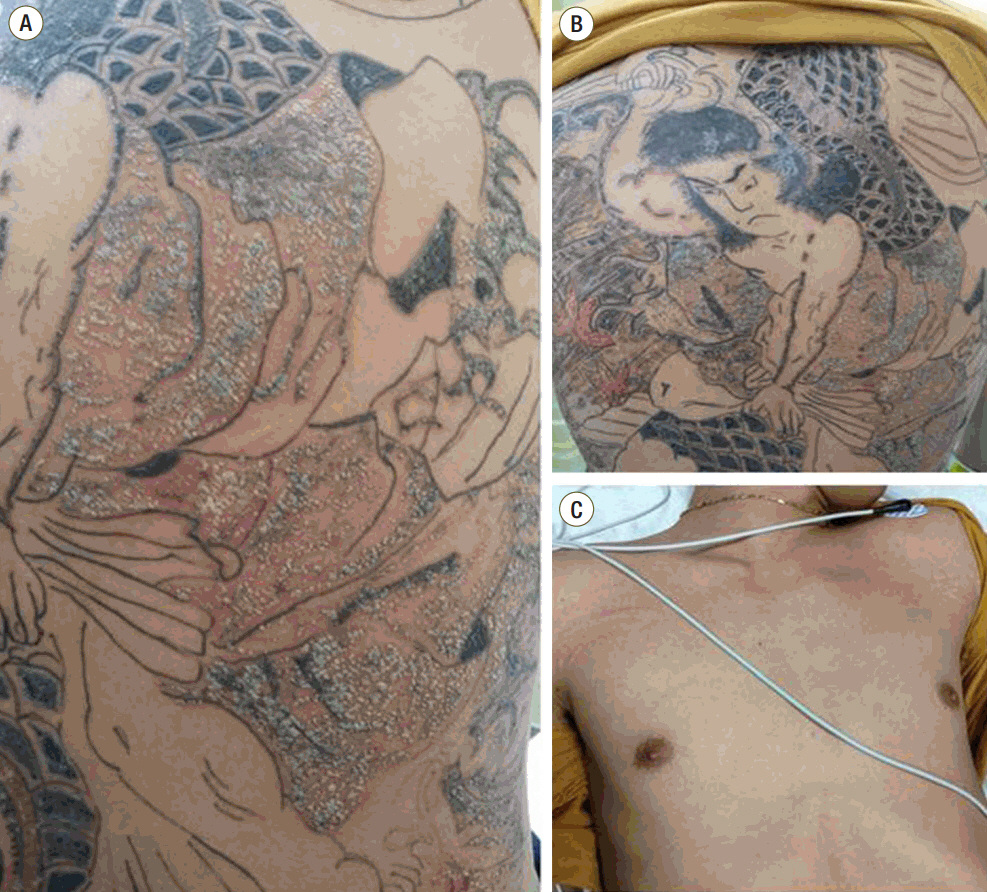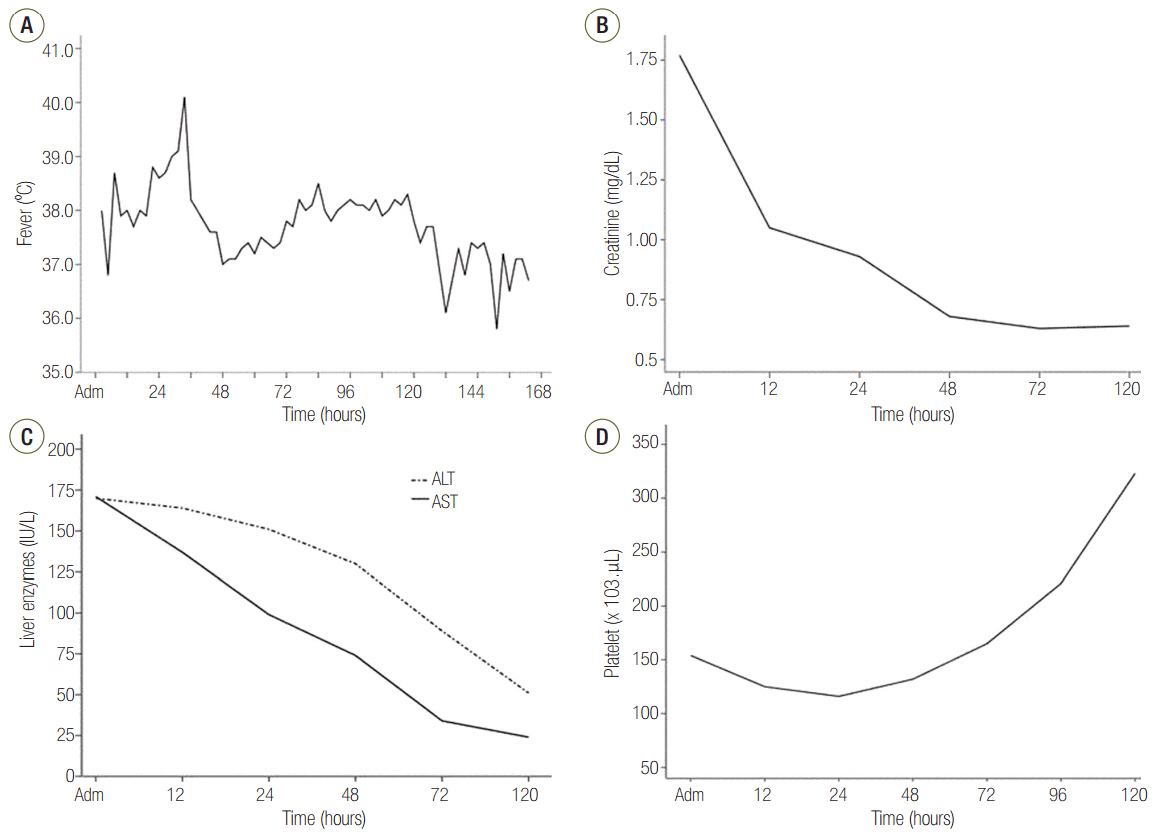Korean J Crit Care Med.
2015 Aug;30(3):184-190. 10.4266/kjccm.2015.30.3.184.
Toxic Shock Syndrome following Tattooing
- Affiliations
-
- 1Department of Emergency Medicine, National Medical Center, Seoul, Korea.
- 2Department of Emergency Medicine, Seoul National University Hospital, Seoul, Korea. kanesu@gmail.com
- KMID: 2227647
- DOI: http://doi.org/10.4266/kjccm.2015.30.3.184
Abstract
- Toxic shock syndrome (TSS) is a rare but life-threatening illness that is mainly caused by toxigenic strains of Staphylococcus aureus. Although TSS is classically known to be associated with tampon use, the number of TSS cases with non-menstrual causes such as skin and soft tissue infection has been increasing. Tattooing can result in several complications such as localized and systemic infections, inflammatory skin eruptions and neoplasms. We recently experienced a 26-year-old man diagnosed with typical TSS following tattooing. He complained of fever, chills and erythematous rash at tattoo site. Subsequently, the patient developed sign of shock. The skin cultures on the tattoo site were positive for methicillin-sensitive Staphylococcus aureus. The patient was successfully treated with vasopressor infusion and intravenous antibiotics and was discharged without complications. On discharge from the hospital 7 days later, desquamations on the tattoo site, fingers and toes were observed.
Keyword
MeSH Terms
Figure
Reference
-
References
1. Lappin E, Ferguson AJ. Gram-positive toxic shock syndromes. Lancet Infect Dis. 2009; 9:281–90.
Article2. Herzer CM. Toxic shock syndrome: broadening the differential diagnosis. J Am Board Fam Pract. 2001; 14:131–6.3. DeVries AS, Lesher L, Schlievert PM, Rogers T, Villaume LG, Danila R, et al. Staphylococcal toxic shock syndrome 2000-2006: epidemiology, clinical features, and molecular characteristics. PLoS One. 2011; 6:e22997.
Article4. Kain KC, Schulzer M, Chow AW. Clinical spectrum of nonmenstrual toxic shock syndrome (TSS): comparison with menstrual TSS by multivariate discriminant analyses. Clin Infect Dis. 1993; 16:100–6.
Article5. Juhas E, English JC 3rd. Tattoo-associated complications. J Pediatr Adolesc Gynecol. 2013; 26:125–9.
Article6. Wenzel SM, Rittmann I, Landthaler M, Bäumler W. Adverse reactions after tattooing: review of the literature and comparison to results of a survey. Dermatology. 2013; 226:138–47.
Article7. Laumann AE, Derick AJ. Tattoos and body piercings in the United States: a national data set. J Am Acad Dermatol. 2006; 55:413–21.
Article8. Makkai T, McAllister I. Prevalence of tattooing and body piercing in the Australian community. Commun Dis Intell Q Rep. 2001; 25:67–72.9. Lande RG, Bahroo BA, Soumoff A. United States military service members and their tattoos: a descriptive study. Mil Med. 2013; 178:921–5.
Article10. Klügl I, Hiller KA, Landthaler M, Bäumler W. Incidence of health problems associated with tattooed skin: a nation-wide survey in German-speaking countries. Dermatology. 2010; 221:43–50.
Article11. Cowan RK, Martens MG. Toxic shock syndrome mimicking pelvic inflammatory dis ease presumably resulting from tattoo. South Med J. 1993; 86:1427–31.12. Bhogal RH, Thomas SS. Necrotizing black tattoo reaction: what’s in a name? Am J Clin Dermatol. 2009; 10:131–3.13. Porter CJ, Simcock JW, MacKinnon CA. Necrotising fasciitis and cellulitis after traditional Samoan tattooing: case reports. J Infect. 2005; 50:149–52.14. Hourmozdi JJ, Hawley DA, Hadi CM, Tahir B, Seupaul RA. Streptococcal necrotizing myositis: a case report and clinical review. J Emerg Med. 2014; 46:436–42.
Article15. Chowfin A, Potti A, Paul A, Carson P. Spinal epidural abscess after tattooing. Clin Infect Dis. 1999; 29:225–6.
Article16. Satchithananda DK, Walsh J, Schofield PM. Bacterial endocarditis following repeated tattooing. Heart. 2001; 85:11–2.
Article17. Tse D, Khan S, Clarke S. Bacterial endocarditis complicating body art. Int J Cardiol. 2009; 133:e28–9.
Article18. Korman TM, Grayson ML, Turnidge JD. Polymicrobial septicaemia with Pseudomonas aeruginosa and Streptococcus pyogenes following traditional tattooing. J Infect. 1997; 35:203.
Article19. Hajjeh RA, Reingold A, Weil A, Shutt K, Schuchat A, Perkins BA. Toxic shock syndrome in the United States: surveillance update, 1979 1996. Emerg Infect Dis. 1999; 5:807–10.20. Descloux E, Perpoint T, Ferry T, Lina G, Bes M, Vandenesch F, et al. One in five mortality in non-menstrual toxic shock syndrome versus no mortality in menstrual cases in a balanced French series of 55 cases. Eur J Clin Microbiol Infect Dis. 2008; 27:37–43.
Article
- Full Text Links
- Actions
-
Cited
- CITED
-
- Close
- Share
- Similar articles
-
- A Case of Group G Streptococcal Toxic Shock Syndrome
- Toxic Shock Syndrome after Mastopexy and Augmentation Mammoplasty with Saline-Filled Mammary Implant
- A Case of Streptococcal Toxic Shock Like Syndrome with Pleural Effusion
- Group B Streptococcal Toxic Shock-like Syndrome: A Case Report and Review of the Literature
- A Case of Toxic Shock Syndrome




